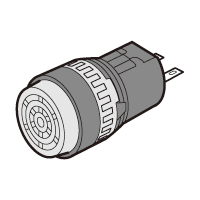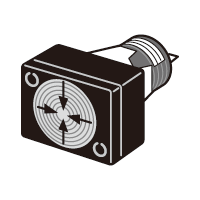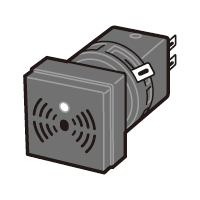(!) Since support from Microsoft will end on January 14 2020, Windows 7 user might not be able to use MISUMI website effectively. Please consider to update your system as ‘MISUMI Website system requirement’.
- แจ้งวันหยุดทำการในเดือน กรกฎาคมและสิงหาคม 2567 | Notice holiday in July and August 2024 > คลิก
OMRON Alarms/Buzzers(Shape:Silique type)
Configure
Specification/Dimensions
-
Volume(dB)
-
Product Type
- Alarm / Buzzer Unit
- Other
-
Rated Voltage(V)
- DC6V
- DC12V
- DC24V
- AC100V
- Other
- DC12~24V
- AC100~240V
-
Shape
-
Sound
- Continuous
- Intermittent
-
Types of sound
- Peak
- Boost
- Voice/music
- Other
-
Volume adjustment
- Available
- NA
-
Terminal shape
- Solder terminal
- Screw terminal
- Insertion Terminal
- Other
-
Dimension width(mm)
-
Protection function (IP/drip-proof, etc.)
-
Representative Standard
-
Dimension length(mm)
-
Dimension thickness(mm)
Brand |
|
|---|---|
Filter By |
|
| CAD |
|
- 3 items
- Sort By
-
You can add up to 6 items per a category to the compare list.

 Until 31/03/2025
Until 31/03/2025 Until 31/03/2025
Until 31/03/2025Buzzer (round body type φ 16) M2BJ
OMRON
Cylindrical ø16 (16‑mm dia.) series alarm/buzzer.
[Features]
· 22‑mm body length.
· Standard volume type. (Constant 80 phons.)
· High-volume type. (Variable between 70 to 95 phons.)
· Switchable between intermittent and continuous sound.From: ฿ 923.00 Special Price Days to Ship: Same day
Same day
-
You can add up to 6 items per a category to the compare list.

 Until 31/03/2025
Until 31/03/2025 Until 31/03/2025
Until 31/03/2025Heater Disconnection Detector K2CU
OMRON
A K2CU heater burnout alarm.
[Features]
· Detects burnouts from small to large capacity heaters.
· Detects heater burnout in molding and packing machinery, etc., and then outputs an alarm.
· Boasts a high level of detection accuracy, enabling detection of single burned out wires, even when using multiple heaters.
· Can be used with a wide range of heaters; from small to large capacity types.
· A single K2CU-F large capacity integrated CT unit can be used for both single and triple-phase heaters.
· The compensation function for fluctuations in voltage
· means that false alarms will not occur due to fluctuations in heater current caused by fluctuations in the voltage from the power supply, ensuring that alarms only occur when applicable.From: ฿ 4,583.00 Special Price Days to Ship: Same day
Same day
-
You can add up to 6 items per a category to the compare list.

 Until 31/03/2025
Until 31/03/2025 Until 31/03/2025
Until 31/03/2025OMRON
An AGD electrical leakage fire alarm.
[Features]
· An updated version of a long-selling product with a 30-year track record.
· The basic functions are maintained but with greater compactness.
· The surface type maintains the same mounting dimensions but has been more compact. The square bodied embedded type has approximately half the volume ratio as previous models (excluding the AGD-U2).
· The built-in digital filter reduces the effects of high-frequency noise, allowing more precise monitoring of electrical leakage.
· The output contact configuration is 1c+1a × the number of monitoring circuits. This enables remote monitoring via external signal contacts, and an alarm output for each monitoring circuit.
· Even the square bodied embedded types come equipped with built-in buzzers (excluding the AGD-U2).
· Can also output an alarm to any external buzzer.
· All updated products are available with either automatic or manual recovery AGD-N5, AGD-NY5, and AGD-N52).From: ฿ 24,890.00 Special Price Days to Ship: Same day
Same day
| Brand |
|---|
| Product Series |
| From |
| Days to Ship |
| Volume(dB) |
| Product Type |
| Rated Voltage(V) |
| Shape |
| Sound |
| Types of sound |
| Volume adjustment |
| Terminal shape |
| Dimension width(mm) |
| Protection function (IP/drip-proof, etc.) |
| Representative Standard |
| Dimension length(mm) |
| Dimension thickness(mm) |
You can add up to 6 items per a category to the compare list. | You can add up to 6 items per a category to the compare list. | You can add up to 6 items per a category to the compare list. | |
| Brand | OMRON | OMRON | OMRON |
| Product Series | |||
| From | ฿ 923.00 Special Price On Sale Until 31/03/2025 | ฿ 4,583.00 Special Price On Sale Until 31/03/2025 | ฿ 24,890.00 Special Price On Sale Until 31/03/2025 |
| Days to Ship | Same day | Same day | Same day |
| Volume(dB) | 70–95 ~ 80 | - | 70 |
| Product Type | - | - | Alarm / Buzzer Unit |
| Rated Voltage(V) | Other | AC100V / Other | Other |
| Shape | Silique type | Silique type | Silique type |
| Sound | Continuous / Intermittent | - | - |
| Types of sound | Peak / Boost | - | - |
| Volume adjustment | Available / NA | - | - |
| Terminal shape | Solder terminal | Screw terminal / Other | Screw terminal |
| Dimension width(mm) | 24 ~ 26 | 72 ~ 90 | 205 |
| Protection function (IP/drip-proof, etc.) | Available | - | - |
| Representative Standard | - | - | - |
| Dimension length(mm) | 18 ~ 20 | 60 | 136 |
| Dimension thickness(mm) | 28.5 | 89 ~ 95 | 153 |
Loading...
Related Categories to Alarms/Buzzers
FAQ Alarms/Buzzers
- Question: How do buzzers function in electrical circuits?
- Answer: Electromagnetic buzzers use an electromagnetic coil to generate a magnetic field. This field attracts a movable diaphragm, causing mechanical vibrations. As the diaphragm moves back and forth, it produces sound waves, resulting in the audible buzzing or beeping sound. Connected to an electrical circuit, the buzzer is activated when current flows through the coil. It's important to note that there are different types of buzzers, including electromagnetic, piezoelectric, and magnetic-transducer buzzers. Each type operates on different principles
- Question: What are the typical uses of buzzers in various industries?
- Answer: Buzzers are widely used in various industries for signaling and alerting. Here are some typical uses of buzzers in different industries such as:
1. Automotive industries: In vehicles, buzzers are employed for warning signals, such as seatbelt reminders, and low fuel indicators.
2. Medical Industries: Medical devices use buzzers for alarms and notifications, such as indicating the end of a medical procedure or alerting healthcare professionals to specific conditions.
3. Industrial Automation: Buzzers are used in manufacturing and industrial settings to signal the completion of processes, indicate faults, or alert operators to specific events.
4. Security Systems Industries: Alarm systems and security devices use buzzers to produce loud alerts in the event of a breach, fire, or other security concerns. - Question: What differentiates piezo buzzers from electromagnetic buzzers?
- Answer:
This table summarizes the key differences between piezo buzzers and electromagnetic buzzers in terms of their operating principles, mechanisms, sound frequency ranges, efficiency, size, and common applications.
Feature Piezo Buzzers Electromagnetic Buzzers Operating Principle Crystal deformation Diaphragm driven by electromagnet Mechanism Crystal vibrations directly produce sound Diaphragm or armature physically moves to create sound Sound Frequency Range Narrow, often in ultrasonic or audible range Broader range, capable of various frequencies Efficiency High efficiency, fast response time Variable efficiency, may have slower response time Size and Weight Generally smaller and lighter Tends to be larger and heavier Applications Compact designs, low power, high-frequency Various applications, broader frequency requirements - Question: What factors determine the loudness of a buzzer?
- Answer: 1. Power Input: Higher electrical power results in increased loudness.
2. Design and Construction: Physical characteristics impact efficiency.
3. Resonance Frequency: Operating at resonant frequency maximizes loudness.
4. Voltage and Current: Increased levels within limits enhance sound output.
5. Environmental Conditions: Surrounding factors influence perceived loudness.
6. Transducer Efficiency: Efficient transducers produce more sound.
7. Sound Output Mechanism: Different mechanisms impact loudness.
8. Duty Cycle: Continuous operation may enhance perceived loudness.
9. Frequency Range: Some frequencies are more noticeable or louder than others. - Question: Can buzzers be considered a form of sound energy?
- Answer: Yes, buzzers can be considered a form of sound energy. Sound energy is a type of mechanical wave that propagates through a medium, such as air, water, or solids. When a buzzer is activated, it typically produces vibrations that create compressions and rarefactions in the surrounding air, generating sound waves. These sound waves carry energy in the form of vibrations, and when they reach our ears, they are perceived as sound.
- Question: How do you integrate a buzzer into a security system?
- Answer: Incorporate a buzzer into a security system by linking it to a controller, such as Arduino or Raspberry Pi. Ensure proper power alignment, connect to a digital output pin, and code the buzzer to respond to security events like unauthorized access detected by sensors.Thoroughly test and calibrate the system, considering backup power.
- Question: How do you choose the appropriate buzzer size and sound level for different environments?
- Answer: Select a buzzer size based on space constraints and application requirements. For quiet environments, opt for smaller, less powerful buzzers to minimize disturbance. In noisy settings, choose larger buzzers with higher sound levels for better audibility. Consider dB ratings to match ambient noise levels; quieter environments need lower dB, while louder surroundings require higher dB ratings. Always test in the specific environment to ensure the chosen buzzer meets the desired sound level without being excessively disruptive or inadequate for the given conditions.
- Question: What are the main considerations when connecting a buzzer to a digital circuit, such as an Arduino or Raspberry Pi?
- Answer: When buzzing with digital circuits, remember these key points:
1. Buzzer type: Choose between active (amplified, needs only digital signal) or passive (requires driver circuit).
2. Voltage and current: Match buzzer specs to your board's capabilities (e.g., 5V for Arduino). Calculate current draw and ensure sufficient power supply.
3. Driving the buzzer: Use a transistor or driver IC for passive buzzers or high current needs. Connect active buzzer directly to a digital pin.
4. Pulse frequency: Control sound pitch and pattern by varying the frequency of the digital signal driving the buzzer (typically 200Hz to 5kHz).
5. Protection: Add a flyback diode across the buzzer to absorb reverse voltage spikes generated when switching it off.
















How can we improve?
How can we improve?